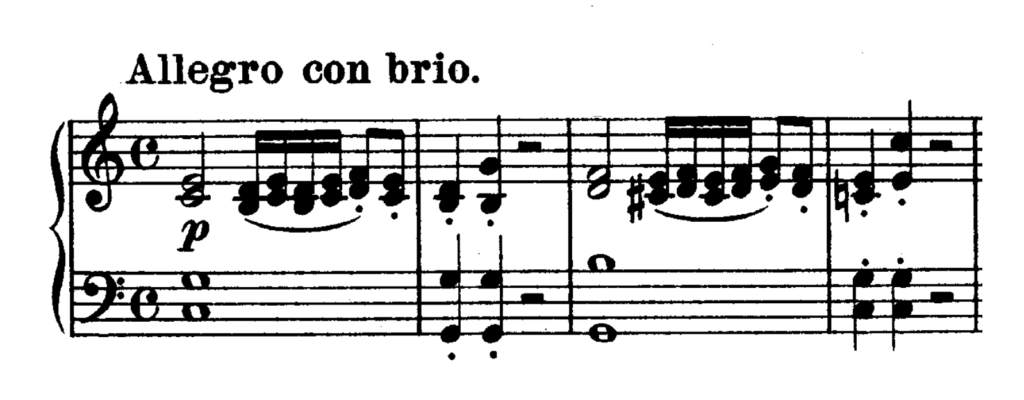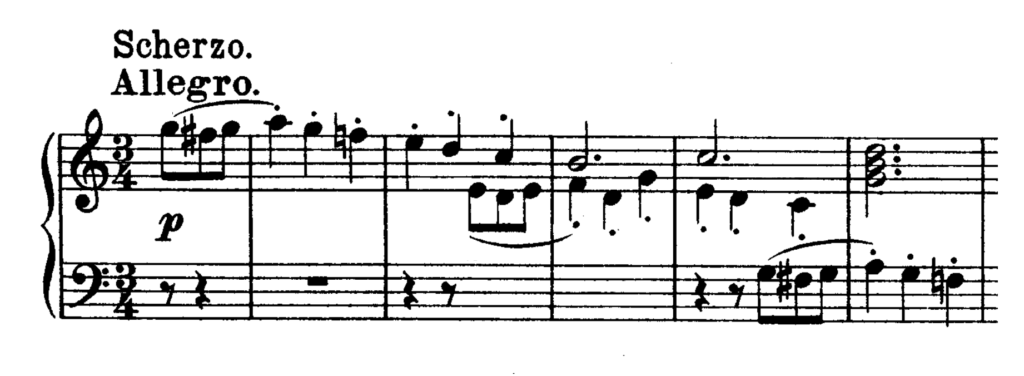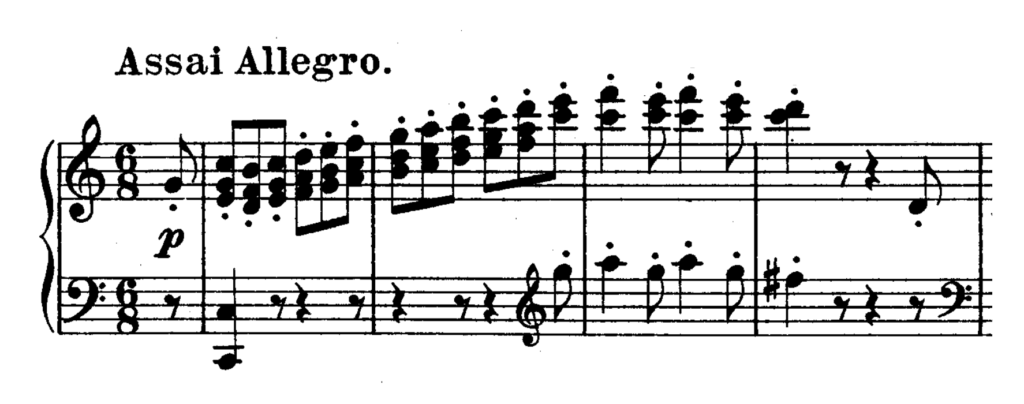Analysis
Contents
For the benefit of all pianists learning this work, we present to you a concise and easy to use analysis of Beethoven’s Piano Sonata Op.2 No.3 in C major.
First Movement (Allegro Con Brio)
Form: Sonata Form. C major.
EXPOSITION:
Bars 1-13: First Subject in C major (tonic). The first subject is constructed almost entirely upon the first bar rhythm, it ends at Bar 8; Bars 9-13 being a varied and prolonged repetition of Bars 5-8.
Bars 13-26: Connecting Episode. The connecting episode is formed of new material; it ends upon the dominant, which is unusual.
Bars 27-77: Second Subject in G minor and G major. The second subject (which is adapted from an early Pianoforte Quartet) begins with a two-bar phrase, succeeded by a four-bar phrase. It is in two parts, G minor (dominant minor), Bars 27-45, and G major (dominant major), Bars 47-77. The second subject recurs in C minor (tonic minor) and C major (tonic major), Bars 162-182. See also Op. 2, No. 2, first movement.
Bars 77-90: Coda. The Coda commences with a short subject, which is afterwards introduced at the beginning of the development.
DEVELOPMENT:
Bars 91-140: The development begins with the subject referred to in the Coda, followed by a brilliant passage in arpeggios. At Bars 103-104 there is an enharmonic modulation leading to the first subject in D major, Bar 110. It closes upon dominant pedal point.
RECAPITULATION:
Bars 140-147: First Subject in original key. The first subject re-appears shortened; the varied repetition of Bars 5-8 being omitted.
Bars 148-161: Connecting episode. The brilliant eight bars at the commencement of the connecting episode are omitted, and a development of the last two bars of the first subject is substituted. The last part is unaltered.
Bars 162-212: Second Subject in C minor and C major.
Bars 212-End: Coda. The Coda begins with the same subject as in the enunciation, followed by a passage in arpeggios leading to a cadenza, after which the movement ends with a reference to the first subject.
Second Movement (Adagio)
Form: Modified Rondo Form. E major.
FIRST PART:
Bars 1-11: First Subject in E major (tonic). The first subject ends at Bar 8; Bars 8-11 being a varied prolongation of Bars 6-8.
Bars 11-43: Second Subject in E minor and G major. The second subject instead of being in B major is principally in E minor and G major. It may be divided into two part: the first part, Bars 11-19, being in E minor and ending in G major; the second part, Bars 19-25, being and ending in G major. Bars 26-37 consists of a development of Part I and Bars 37-43 of a varied repetition of Part II.
Bars 43-53: First subject in original key.
SECOND PART:
There is no second part of any kind in this movement.
THIRD PART:
Bars 53-54: These two bars are in C major are suggestive of the first subject. As the third subject is omitted, another repetition of first subject is unnecessary here.
Bars 55-66: Second Subject in E major (tonic). The second subject re-appears considerably curtailed. It commences with a passage, Bars 55-58, suggestive of the first part, modulating to E major, in which the second part occurs. Bars 26-42 are omitted.
Bars 67-77: First Subject (varied) in original key.
Bars 77-End: Coda. The coda refers to the first subject.
Third Movement (Allegro)
Form: Scherzo and Trio. C major.
FIRST PART – Scherzo:
The Scherzo is in Simple Binary form.
Bars 1-17: First Subject in C major (tonic), ending in G major.
Double bar and repeat.
Bars 18-41: Development. At Bar 20 of the development a figure is introduced, which appears in the Coda.
Bars 41-57: First Subject in original key altered so as to end in the tonic key.
Bars 57: Coda.
Double bar and repeat from Bar 18.
SECOND PART – Trio:
The Trio is in Simple Binary form.
Bars 1-8: First Subject in A minor (tonic), ending in E minor.
Double bar and repeat.
Bars 9-18: Development.
Bars 18-25: First Subject in original key so as to end in A minor (tonic).
Bars 25-42: Instead of the usual double bar and repeat, the repetition is written out in full, with slight alteration at the end.
THIRD PART – Scherzo:
Da Capo.
Bar 43-End: Coda.
Fourth Movement (Allegro Assai)
Form: Rondo Form. C major.
FIRST PART:
Bars 1-9: First subject in C major (tonic). The first subject consists of two sections of equal length (four bars), both constructed upon the same rhythm, forming a sentence of eight bars.
Bars 9-30: Episode. The episode is formed upon dominant pedal point, followed by a varied repetition of the first section of the first subject, and some development of Bars 4-5.
Bars 31-64: Second Subject in G major. The second subject commences in G major, it modulated to G minor, Bar 44, and ends Bar 64, after eight bars upon dominant pedal point.
Bars 64-70: Bars 64-69 form a passage leading to the second entry of the first subject.
Bars 70-77: First Subject in original key.
SECOND PART:
Bars 77-182: Development and Third Subject in F major. The development commences with a reference to the first subject followed by a passage leading to the the third subject, which enters in F major, Bar 104, in two-bar rhythm. At Bar 144 there is a development of the first two phrases of the third subject ending upon dominant pedal point, which continues for 13 bars, preparatory to the third entry of the first subject.
THIRD PART:
Bars 182-197: First Subject in original key. The first subject re-appears with a varied elongation.
Bars 197-218: Episode. The last five bars of the episode are altered to end in G instead of D. Compare Bars 25-29 with Bars 213-217.
Bars 219-254: Second Subject in C major (tonic). The first part of the second subject re-appears transposed into the tonic key and elongated by two bars. The second part remains in the same key as before, slightly varied
Bars 254-260: Bars 254-259 form a passage preparatory to the fourth entry of the first subject.
Bars 260-End: First Subject (abbreviated) in original key. The re-appearance of the first subject takes the form of a Coda. The second subject does not appear in its entirety. Note the inverted pedal points, Bars 260-265, and the prolonged interrupted cadence where the chord of the dominant seventh (by raising the fifth D to D sharp) resolves into the chord of A major, Bar 299.










